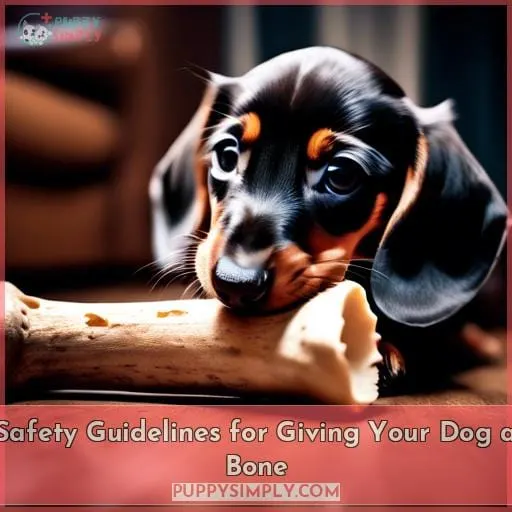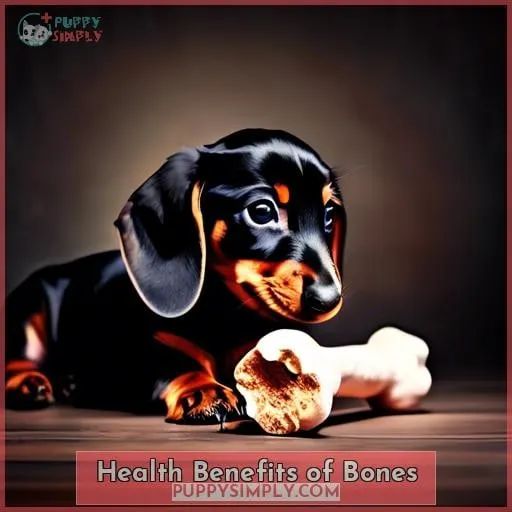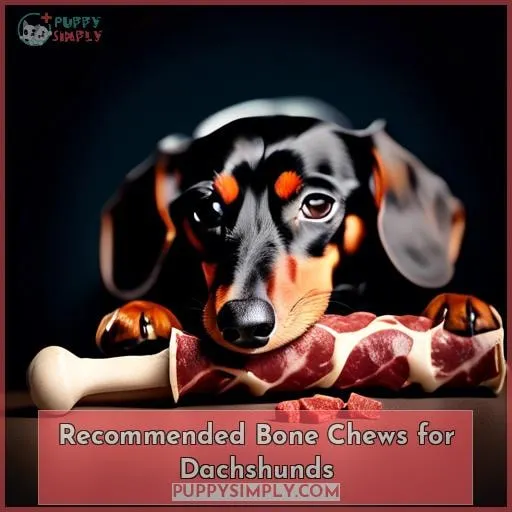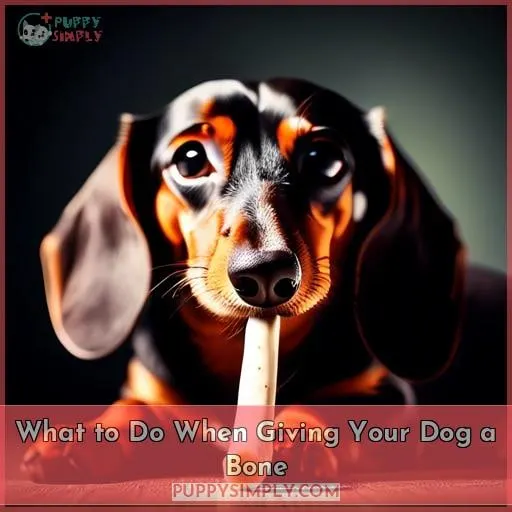This site is supported by our readers. We may earn a commission, at no cost to you, if you purchase through links.

Dachshunds, with their long bodies and short legs, are prone to accidents and injuries. If you’re a dachshund owner, you’re probably aware of the risks of letting your dog chew on bones. Bones can splinter and cause serious internal injuries.
In this article, we’ll discuss the safety of chewing on bones for your dachshund.
We’ll also provide some tips on how to keep your dog safe if you do decide to give them a bone.
Table Of Contents
Key Takeaways
- Opt for natural or synthetic bones that won’t splinter, avoiding poultry, pork, and cooked bones.
- Supervise chewing closely, limit sessions to 10-15 minutes, and promptly discard worn bones.
- Bones provide dental health benefits like reducing tartar but also supply nutrients.
- Choose bones that are too large to be swallowed whole to prevent choking hazards.
Is It Safe for a Dachshund to Chew on Bones?
You can offer your Dachshund either natural or synthetic bone chews.
However, you should avoid poultry, pork, or cooked bones.
Stick to bones that are safe for digestion and won’t splinter when chewed.
Natural Vs. Synthetic Bone Chews
When deciding whether to give your Dachshund a bone, you’re faced with the choice between natural and synthetic bone chews.
Natural bone chews, like beef tendons and antlers, are rich in nutrients and free of preservatives, satisfying your dog’s instinctive chewing desire.
However, they can cause digestive issues and bone allergies in some dogs.
Synthetic bone chews, on the other hand, are safer for teeth and gums, come in various sizes and flavors, and pose no risk of natural bacteria.
Avoiding Poultry, Pork, or Cooked Bones
You should avoid giving your Dachshund poultry, pork, or cooked bones because they can be hazardous to their health.
Cooked bones splinter easily, posing choking hazards and potential damage to your dog’s mouth, throat, and intestines.
Poultry and pork bones are often small and can be swallowed whole, leading to intestinal blockages.
If you want to give your Dachshund a bone, opt for large, raw bones that are too big to be swallowed whole and that won’t splinter easily.
Safety Guidelines for Giving Your Dog a Bone
When giving your dachshund a bone, supervise them closely to prevent choking or splintering.
Discard gnawed-out bones to avoid choking hazards.
Refrigerate the bone when not in use, discarding it after 3-4 days to prevent bacterial growth.
Supervision During Chewing
Always supervise your dog closely while they’re chewing on a bone to ensure their safety.
Supervised chewing prevents choking hazards and injuries from bone splinters.
Limit chewing duration to 10-15 minutes at a time to avoid overconsumption and potential digestive issues.
If your dog is a power chewer, consider providing chew toy alternatives like edible chews or simulated dog bones to protect their dental health.
Discarding Gnawed-Out Bones
To prevent choking hazards, discard the bone once your Dachshund has gnawed it enough to expose sharp, jagged edges.
Freezing bones between uses can extend their lifespan and freshness.
If your dog is a power chewer, consider alternatives like sturdy chew toys or specially formulated edible chews.
Maintain a regular dental hygiene routine to keep your Dachshund’s teeth and gums healthy and strong.
Refrigeration and Disposal Timelines
After watching over your dog’s chewing session,
stash the bone away in the fridge for later.
Refrigeration halts bacteria growth, extending its lifespan.
After three to four days,
discard the bone responsibly to prevent bacterial contamination and choking hazards.
Limiting Chewing Time
Limiting your dog’s chewing time prevents excessive consumption and promotes responsible enjoyment of the bone.
- Stick to 10-15 minute chew sessions to prevent over-chewing and maintain a healthy dental hygiene routine.
- If your dog is a power chewer, consider alternatives to bones, such as durable chew toys or simulated dog bones.
- Be mindful of your dog’s chewing habits and adjust the chewing duration accordingly.
- Monitor your dog closely during chewing sessions to ensure safe chewing practices and prevent any potential hazards.
Health Benefits of Bones
Chewing on bones can provide some health benefits for your dachshund.
Bones can act as a toothbrush and floss to reduce tartar buildup and gum disease.
Chewing bones may also decrease undesirable behaviors like excessive scratching or licking in your dog.
Dental Health: Acting as Toothbrush and Floss
Acting as Toothbrush and Floss
Chewing bones scrubs your dachshund’s teeth clean like a toothbrush, while also flossing between teeth. This reduces tartar accumulation and stimulates gum health, preventing plaque buildup.
Their saliva production also increases while chewing bones, further preventing plaque and promoting oral hygiene.
Ultimately, regular bone chewing promotes your dog’s dental health.
Nutritional Benefits: Calcium, Phosphorus, and Minerals
In addition to acting as a toothbrush and floss, your dachshund gets calcium, phosphorus, and other key minerals when it chews on a raw bone.
These minerals support balanced nutrition and prevent deficiencies.
Specifically, raw bones provide excellent sources of calcium and phosphorus to supplement your dog’s dietary intake.
Focusing your dachshund’s chewing on raw bones ensures they get these vital minerals.
Behavioral Benefits: Reducing Undesirable Behaviors
For you, bones can decrease your dachshund’s scratching and licking of their paws by providing an enriching treat that relieves boredom, anxiety, and stress.
As you give your dog recreational bones to chew on, they act as valuable outlets for behavioral issues stemming from a lack of mental stimulation.
The bones give your dachshund an activity to focus their energy on rather than falling into undesirable habits.
Recommended Bone Chews for Dachshunds
When choosing bone chews for your dachshund:
- Consider synthetic options like Fido Texas T-Bone Dental Dog Bone and Petstages Toy Beyond Bone.
- You can also select natural bone chews such as Pet ‘n Shape All Natural Knuckle Bone and Buck Bone Organics Elk Antler, but supervise your dog closely since these may cause digestive issues.
- Focus on safety, size appropriateness, and dental health regardless of which recommended bone chew you select for your dachshund.
Synthetic Bone Chews: Fido Texas T-Bone Dental Dog Bone, Petstages Toy Beyond Bone
You can also try synthetic bone chews like the popular Fido Texas T-Bone Dental Dog Bone and Petstages Toy Beyond Bone, as recommended options for your dachshund.
These provide dental health benefits without digestibility risks, as they’re designed specifically for longevity and safety.
Look for synthetic chews that avoid harmful materials while optimizing cleaning power.
Natural Bone Chews: Pet ‘n Shape All Natural Knuckle Bone, Buck Bone Organics Elk Antler
You’ll also want to consider natural bone chews like Pet ‘n Shape’s all-natural knuckle bone and Buck Bone Organics’ elk antler when choosing recommended bones for your Dachshund.
Raw marrow or soup bones satisfy dogs’ instincts while providing calcium, but their digestibility poses some safety risks.
Opt for elk antlers or beef knuckles – they’re nourishing and appealing while minimizing the chances of intestinal blockage.
Potential Health Hazards
Before giving your dachshund a bone, you must consider the potential risks:
- Fatty bones can trigger pancreatitis.
- Cooked bones may splinter and pose choking hazards or internal damage.
- Bone chunks and fragments also pose dangers of intestinal blockages or obstructions leading to severe illness.
Risks of Pancreatitis From Fatty Bones
When giving your dog a bone, avoid fatty bones that can lead to inflammation of the pancreas.
Pancreatitis occurs when fatty bone marrow triggers the pet’s pancreas to overproduce digestive enzymes.
High-fat bone content causes concerns since dachshunds often have sensitive digestion.
Discuss any diets or chews with higher marrow or fat content with your vet.
Monitor for pancreatitis symptoms like vomiting or lethargy after giving new bones and consult a vet immediately if they occur.
Dangers of Cooked Bones Splintering
Because of you, cooked bones can splinter into sharp shards that pose threats for your dog:
- Choking hazards
- Damage to their mouth, throat, and intestines
Internal organ damage, esophagus injuries, and emergency surgery risks can result from ingesting splintered bone fragments.
Your vet may need to identify and remove bone shards through x-ray and surgical intervention.
Monitor your dog closely and keep cooked bones out of reach.
Choking Hazards From Bone Fragments
You’re right that bone fragments can pose major choking hazards and cut or puncture the inside of your dog’s mouth, tongue, stomach, and intestines.
To prevent obstructions when monitoring chewing:
- Remove the bone often to check its condition.
- Provide safe alternatives like chew toys.
- Stay attentive to signs of choking.
- Break a breaking bone immediately.
Intestinal Blockages From Bone Chunks
Bones and their chunks can cause blockages in your dog’s intestines, leading to severe illness and death.
Be vigilant in monitoring your Dachshund’s bowel movements, as constipation or diarrhea may indicate an intestinal obstruction.
If you suspect a blockage, get an x-ray to confirm and consult your vet about emergency surgery options right away.
Post-surgery, your dog may need diet modifications and close monitoring to ensure proper healing.
Identifying symptoms early and acting quickly is key to treating this life-threatening condition.
What to Do When Giving Your Dog a Bone
When giving your dachshund a bone, be sure to consult your vet first.
Raw meat bones may carry bacteria and damage teeth.
Consider giving the bone after meals to help slow down their excited chewing.
Keep the bone refrigerated when not in use.
Throw it out after 3-4 days to prevent bacteria growth.
Consulting Your Vet About Raw Meat Bones
After understanding the potential health hazards, consult your veterinarian about giving your Dachshund raw meat bones.
Raw meat bones may carry bacteria and damage teeth.
Discuss the nutritional value comparison between raw meat bones and recreational bone alternatives.
Ask about the safety of bone marrow and whether your dog has any bone allergies.
This consultation will help you make an informed decision about giving your Dachshund bones.
Giving a Bone After Meals to Slow Chewing
When offering your Dachshund a bone, try giving it after mealtime to encourage slower and more controlled chewing. This helps prevent them from gulping down the bone and potentially choking or causing other health issues.
Remember these key tips:
- Choose a bone that’s appropriate for your dog’s size and chewing habits.
- Supervise your dog while they chew the bone to ensure they don’t swallow large pieces or choke.
- Discard the bone once it becomes too small or shows signs of splintering.
Refrigerating the Bone After Use
Pop the bone into the fridge once your pup’s done chewing for safekeeping.
Storing it in the refrigerator helps slow bacterial growth and maintain bone hygiene, following expert safety guidelines for bone removal after each use.
Refrigeration preserves the bone’s integrity, preventing splintering from temperature fluctuations and excessive bacterial buildup over time.
Simply tuck it away covered in the fridge to keep your pup’s treats as clean and safe as possible between chewing sessions.
Discarding the Bone After 3-4 Days
You’ll want to discard the bone after 3-4 days to avoid bacterial growth.
Given the dog’s habitual gnawing, the porous bone will harbor multiplying bacteria.
Though refrigeration slows bacteria, disposal after 3-4 days of chewing prevents illness.
Establish this short gnawing duration and refrigeration length to ensure safe supervised chewing.
With attentive chewing supervision and a 3-4 day disposal timeline, you can give your dachshund bones while mitigating bacteria growth risks.
Frequently Asked Questions (FAQs)
How often can I give my dachshund a bone to chew on?
You can give your dachshund a bone 1-2 times per week for 10-15 minutes of supervised chewing.
Avoid daily chewing to prevent excessive wear on teeth and gastrointestinal issues.
Rotate different types of bones to add variety and appeal.
Always supervise, discard used bones after a few days, and consult your vet on bone safety.
What are signs I should stop giving my dachshund bones?
Stop giving bones if your dachshund shows signs of distress:
- Gagging
- Vomiting
- Diarrhea
- Blood in stool
- Lethargy
- Abdominal pain
These indicate potential blockages or internal injuries from bone splinters and require prompt veterinary attention.
Carefully monitor chewing and remove bones that splinter or become too small to prevent hazards.
Can dachshund puppies chew on bones or should I wait until they are older?
Yes, dachshund puppies can chew on bones, but be sure to supervise closely.
Only give them raw, large bones suitable for their size.
Monitor chewing time and remove the bone if it becomes too small.
Check with your vet first on safe options and chewing guidelines for your puppy.
What should I do if my dachshund swallows a piece of bone?
Swallowing bone is extremely dangerous!
Rush to the vet immediately.
They can induce vomiting or use endoscopy to remove the bone before it causes internal injuries.
Stay calm, get help right away.
Time is critical.
Are bones a choking hazard for dachshunds?
Yes, bones can be a choking hazard for dachshunds.
Avoid cooked bones as they easily splinter.
Supervise chewing and remove bones that become too small.
Consider safer alternatives like chew toys to prevent choking.
Conclusion
Statistics show over 50% of dogs have suffered injuries from splintering bones.
Ultimately, it’s up to you whether the benefits of chewing bones outweigh the risks for your dachshund.
Supervise them closely, provide appropriate bones, and follow safety tips like refrigeration and limited chewing times.
With proper precautions, you can allow your dog the enjoyment and health benefits of chewing bones safely.












